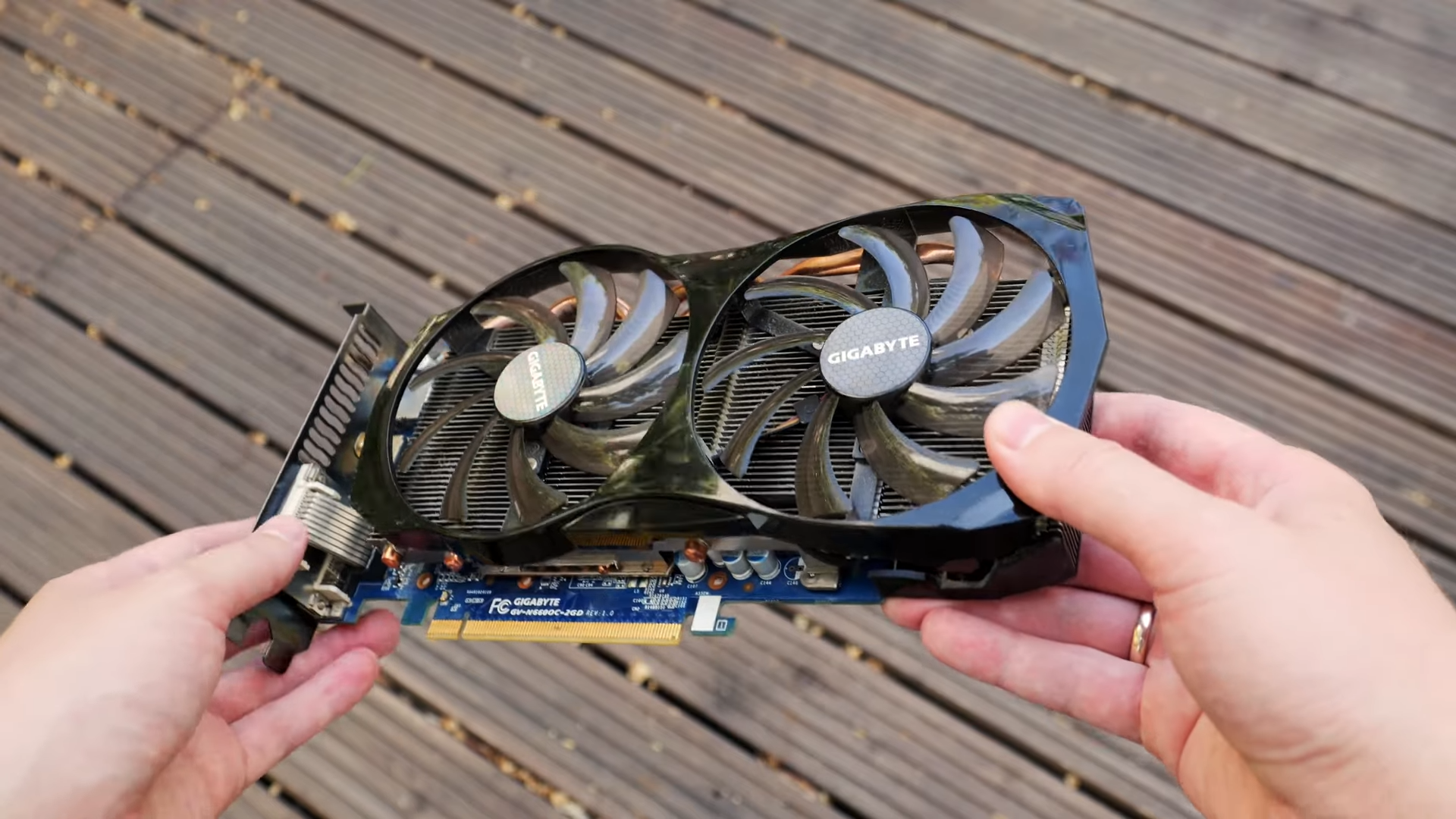Even upscalers can't resuscitate a $10 GPU—13-year-old GTX 660 is so slow that FSR can't give it a boost

A hardware enthusiast has taken an old GTX 660 out of retirement to see if modern upscaling technologies can make the ancient Kepler-based video card functional in 2025. GCS Hardware on YouTube published a video testing the GTX 660 in several games, including some that feature upscaling and some that don't. Despite technically supporting FSR, the GPU ended up being too slow to take advantage of it.
The enthusiast tested four titles: Counter-Strike 2, GTA V, Cyberpunk 2077, and Doom 2016, but only two of the four had upscaling support. Counter-Strike 2 proved to be a best-case scenario for the GTX 660, running at around 80-90 FPS at native 1080p on the lowest settings. The YouTuber tried to use FSR to boost performance higher but discovered FSR yielded no additional FPS improvements whatsoever, despite FSR rendering the game at a significantly lower internal resolution (balanced and performance mode were tested, but yielded the same aforementioned results).
Cyberpunk 2077 (to no one's surprise) ran the poorest of the four, running at just 10 FPS, 15 at the lowest possible settings at native 1080P. FSR 2.1 performance mode was able to lift performance up to the low 20s (according to GCS Hardware's FPS counter), but the game ultimately broke with FSR and ended up with a black screen. XeSS and FSR 3.1 were practically unsupported; XeSS dropped the game's frame rates all the way down to 1 FPS, and turning on FSR 3.1 caused the game to crash.
Attempting to use FSR upscaling in Cyberpunk 2077 and CS:2 reveals that the GTX 660 is too old to run modern upscaling technologies effectively. The GTX 660 came out 13 years ago, featuring Nvidia's Kepler architecture. The GPU was a mid-range card for its time, featuring a GK106 die fabbed on TSMC's 28nm process node, sporting 960 shader cores, 80 TMUs, 24 ROPS, 384 KB of L2 cache, 1,032MHz boost clock, and a 140W TDP. The GTX 660's memory subsystem features 2GB of GDDR5 memory, operating on a 192-bit wide memory bus, featuring 144.2 GB/s of memory bandwidth.
Upscaling technologies such as FSR 2.x, 3.x, and XeSS (DP4a) are capable of running on a broad range of new and old hardware, but these technologies were never designed to run on cards as old as the GTX 660. XeSS minimum GPU requirements are limited to the GTX 10 series, and AMD recommends the GTX 10 series and above for FSR upscaling.
Hardware compatibility may be the main culprit preventing these upscalers from working well at all on the GTX 660. XeSS requires Shader Model 6.4, but the GTX 660 only supports up to Shader Model 5.1. FSR 2 technically supports the GTX 660, but has to rely on a FP32 fallback to run at all on the Kepler GPU. FSR was designed to run on FP16 half-precision compute, but the developers implemented a FP32 single-precision fallback to support older GPUs that don't support FP16 at the cost of performance.
Kepler technically supports FP16, but the architecture is only capable of storing or loading FP16 values. Native FP16 operations are converted to FP32. Pascal (GTX 10 series) was the first consumer Nvidia architecture to natively support FP16 compute.
Get Tom's Hardware's best news and in-depth reviews, straight to your inbox.
Even if the GTX 660 supported native FP16, it is highly doubtful the GPU would perform any better with FSR as it does with its FP32 fallback mode. Upscalers are compute-intensive and require a certain amount of compute power to upscale an image from a lower resolution to a higher resolution. If a GPU is too slow, it will spend too much time upscaling each frame, nullifying any potential FPS improvements.
Follow Tom's Hardware on Google News to get our up-to-date news, analysis, and reviews in your feeds. Make sure to click the Follow button.

Aaron Klotz is a contributing writer for Tom’s Hardware, covering news related to computer hardware such as CPUs, and graphics cards.
-
Notton I think this signifies there is a huge void left where the GTX1030/1050 used to exist in.Reply
Cheap (<$80), AV1 encode/decode, 4x video ports, single slot, low profile, 75W (no additional power connector). -
Alex/AT Actually I'd favor $10-$20 GPU that can draw desktops and consoles well. Good for Windows-based machines that do not need any fancy GPU stuff.Reply -
Li Ken-un Reply
Everything but cheap and single slot: NVIDIA RTX 4000 SFF Ada GenerationAV1 Encode/decodeNotton said:I think this signifies there is a huge void left where the GTX1030/1050 used to exist in.
Cheap (<$80), AV1 encode/decode, 4x video ports, single slot, low profile, 75W (no additional power connector).
4 \00d7 Mini DisplayPort
Low-profile
70 W, no additional power connector
~$1,500Two slotsI struggled with the last option the most. To check off everything, one would have to give up on NVIDIA and look to low-end Intel Arc-based solutions―and I mean low-end amongst even the options within the Intel Arc lineup. Alternatively, some modders are offering their services to turn what should be a two-slot NVIDIA RTX 4000 SFF Ada Generation graphics card into a single-slot card.
In any case, the “< $80” criterion is no longer attainable. -
TCA_ChinChin Reply
I'd say those last two are complete deal breakers for many looking for a GTX1030/1050 replacement. I think the MSRP is something thats impossible to reach nowadays, but something that is:Li Ken-un said:Everything but cheap and single slot: NVIDIA RTX 4000 SFF Ada GenerationAV1 Encode/decode
4 \00d7 Mini DisplayPort
Low-profile
70 W, no additional power connector
~$1,500Two slotsI struggled with the last option the most. To check off everything, one would have to give up on NVIDIA and look to low-end Intel Arc-based solutions―and I mean low-end amongst even the options within the Intel Arc lineup. Alternatively, some modders are offering their services to turn what should be a two-slot NVIDIA RTX 4000 SFF Ada Generation graphics card into a single-slot card.
In any case, the “< $80” criterion is no longer attainable.
AV1 Encode/Decode
low-profile
75W, no additional power connector
sub 200$
single slotWould be great. You mention it youself, but I say for a lot of people who bought 1030/1050s, the low end Intel Arcs would be perfect replacements. Also, if the RTX5050 was lower power and didn't require additional PCIe power, it would've been a good replacement, even if the MSRP is high. More people would accept a 2x or 3x increase in price for a modern Nvidia replacement but more than 10x the price? Thats not even in the same ballpark. -
jlake3 Reply
The problems with this are:Alex/AT said:Actually I'd favor $10-$20 GPU that can draw desktops and consoles well. Good for Windows-based machines that do not need any fancy GPU stuff.
Even the weakest, smallest die still needs to be paired with a board and cooler and 2-4gb of VRAM, then put into a box and shipped, and still have some margin left by the time it makes it to the shelf for the retailer to make a profit. Used hardware more-or-less bottoms out around here due to platform fees and shipping and the time it takes to manage the selling, even when the cost of the goods is basically free.
Intel's UHD Graphics 770 iGPU can do four displays if the motherboard has the ports to support it, and a lot of Windows boxes for basic office use from the likes of Dell and HP can be configured with three ports. The OEM demand for these kind of cards isn't there anymore. -
Notton At $200, the RTX 3050 6GB and RTX A400 4GB become an optionReply
Both do not require a power connector, both have LP, but the A400 also has LP+single slot.
However, they're both a 100% jump in price from a 1030, and both don't support AV1 encode, only decode.
Good luck finding an Arc A310/A350.
AMD has nothing to offer in this price range, very disappointing, seeing as they're the main company selling CPUs without an iGPU with their AM4 lineup. -
Jadesphynx But I bet geforce now would work on it. Fooling around with an i5-4570 + rx550 build in my garage right now and cyberpunk is very playable with geforce now.Reply -
jeremyj_83 Reply
Modern iGPUs can already do that and at lower power draw. Then it all depends on the number of video ports your motherboard has. Sadly most are only 3 so you would need to use something like DisplayLink for a 4th monitor.Notton said:I think this signifies there is a huge void left where the GTX1030/1050 used to exist in.
Cheap (<$80), AV1 encode/decode, 4x video ports, single slot, low profile, 75W (no additional power connector). -
Notton Reply
Unless you're like me and bought a 5800X3D with no such luxury as an iGPU.jeremyj_83 said:Modern iGPUs can already do that and at lower power draw. Then it all depends on the number of video ports your motherboard has. Sadly most are only 3 so you would need to use something like DisplayLink for a 4th monitor.
Seeing as AMD is the primary seller of iGPU-less desktop CPUs, maybe they should pick up the slack?
AMD just released the 5500X3D, also an iGPU-less solution, so they're still creating the source of the problem. -
usertests The funny part is that the performance level may be acceptable, low as it is, but it could really use 4 GB of VRAM.Reply
